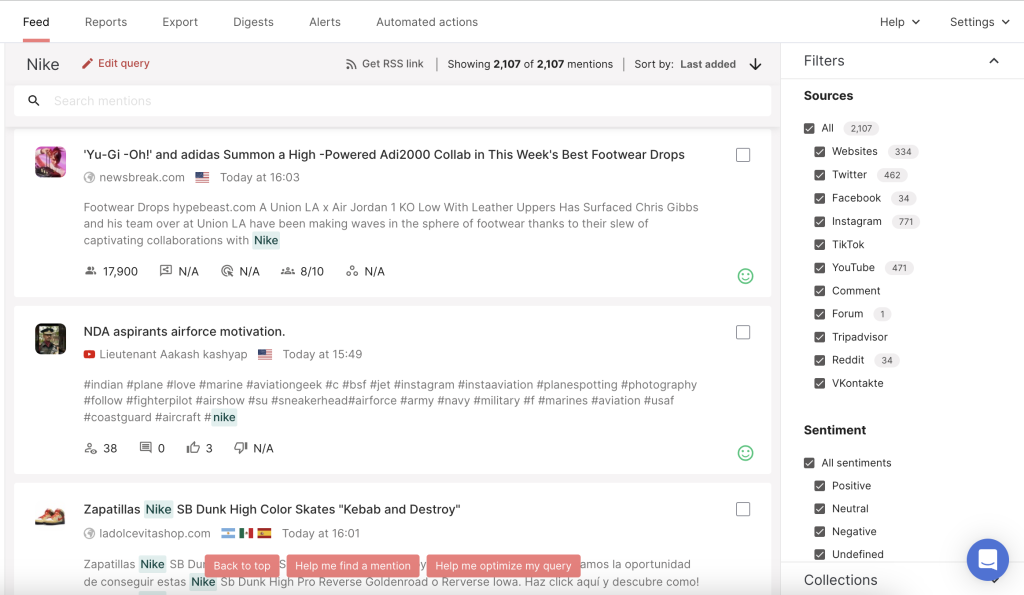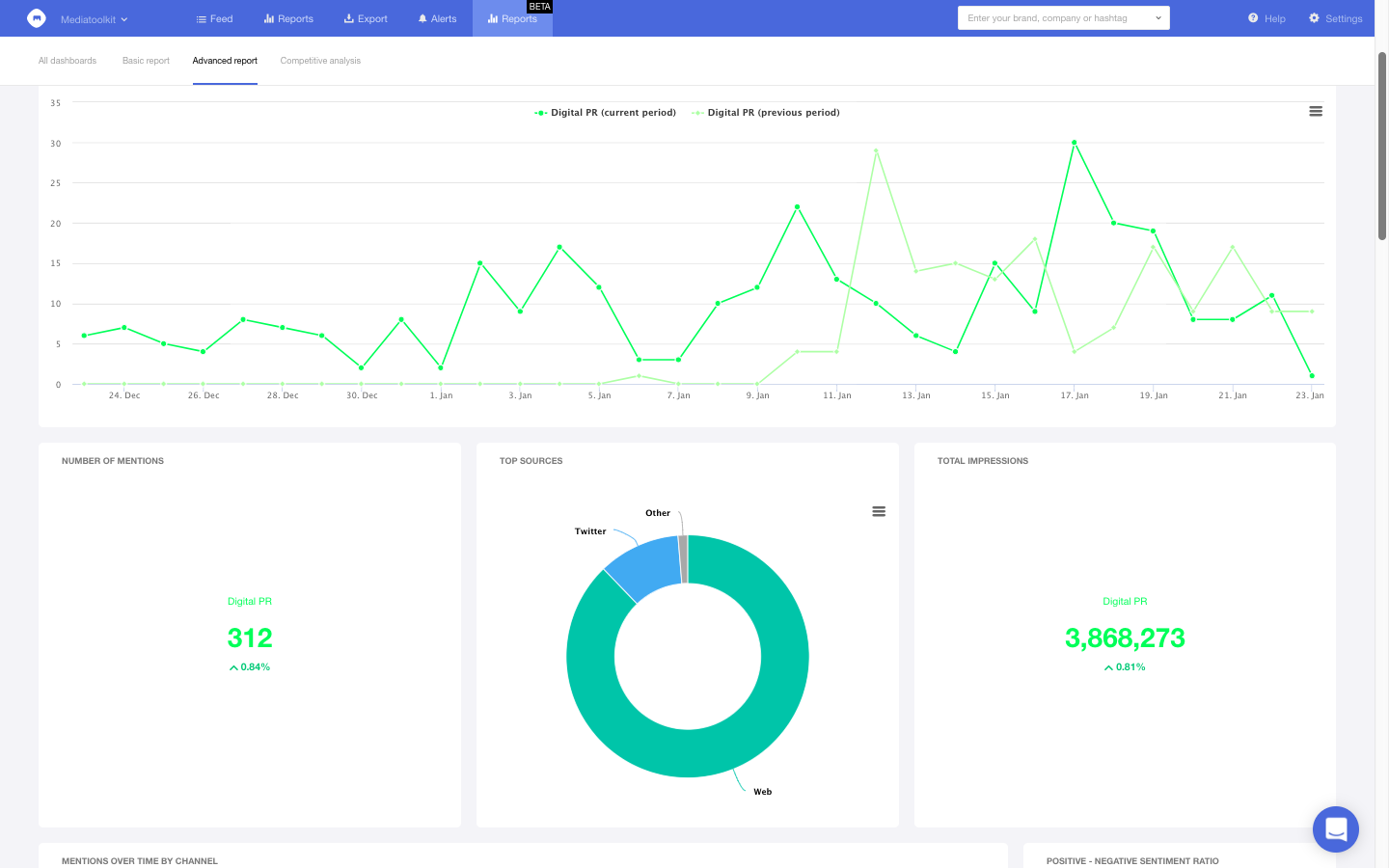Every marketing pitch has one common goal – to land a new client and seal the deal. And to be able to do it effectively, you’ll need to do a lot of research and find out as much as you can before you even start writing it. To make things a bit more difficult, you can be sure that there’s some other agency doing the exact same thing like you.
So how to get the crucial data that will differentiate your marketing pitch from all others? The answer is by social listening.
? Read Media Monitoring: The Ultimate Guide
In this blog we’ll give you an overview of what social listening actually is and how you can use it to perfect your marketing pitch.
Read on!
What is Social Listening?
Social listening is the process of gathering all online mentions of a brand or a company and mining data for valuable marketing insight.
The source of these mentions may be everything from website articles about your company to tweets or comments in a Facebook group.
Why is this beneficial?
Traditional media monitoring tools monitor the press, TV, and radio. Social listening goes beyond that: in addition to media mentions, it finds conversations actual customers are having on social media and forums.
So, if you work for a PR or marketing agency, data from a social listening tool can reveal tons about how people perceive your clients and campaigns. What is more, all of this can give you a better picture of the company you’re writing your marketing pitch for.
Read Complete Guide to Social Listening: Proven Hacks, Strategies, and Tools
How to Prepare a Marketing Pitch with Social Listening
Writing a marketing pitch is a common marketing practice.
It involves the line of talk which is designed to persuade somebody to buy your products or services.
Since only a handful of marketing agencies are using social listening tools for market research, this is your chance to stand out.
To put this in a real-world example, let’s say that a local beer brand is requesting a proposal for services of digital marketing strategy and consulting. Other agencies will deliver a pitch based on how they think the target audience is behaving, how big that audience is, or how fierce is the brand’s competition.
You are going to do that as well, but you are also going to use social listening to give significant added value to your pitch.
Best part?
It takes just a couple of hours to get all the data you need.

Start by monitoring keywords in a social listening tool
Social listening tools are very often web-based, which means you can access them via any browser. Additionally, some of them have supporting mobile apps, which can make al the search easier and more accessible.
Once you register to a tool of your choice, you need to input the name of the brand to start tracking it. Then you can fine-tune your search to a country or a language of your choice, and you’re on your way.
Analyze the Current Brand Image of the Company You’re Pitching to
In order to create a wow effect, you need to deliver something that your potential client is not aware of. Or maybe something that they know, but that can’t be traced by a simple Google search.
For that reason, it may be useful to insert the potential client’s brand name, their key people and maybe a couple of topics from their industry in a social listening tool like Determ and track them for a while. This will give you information on how the company and its key people are perceived in general, you will be able to pull out some of the comments from social media, show which words are most commonly used in relation to the brand and analyze if the campaigns so far align with all of that and if what they’re doing right now makes sense or not.
Display What the Competition is Doing
Taking a look at your competitors’ backyard is always a must, especially when you’re trying to impress a potential client!
In this case, make sure to point put to their competitors’ weaknesses in comparison to the client’s brand image and pull out what you can learn from them. Analyze the sentiment of both companies, who is stronger on which channel, the difference in communication strategies and try to find out the competition’s pain points. A simple competitive report might display all of this information very clearly.
Propose Action Points Based on the Findings
After you’ve displayed and analyzed the results make sure to propose a very clear action plan, based on the findings.
So going back to our beer brand, this is the information you will be able to pull out from your social listening tool:
- How many people are currently talking about the product in question?
- Which channels see the most engagement – Twitter, Facebook, Instagram, TikTok or website articles?
- How many people are currently being reached by the product in question?
- At what time of the day is the target audience most actively discussing the product?
- How does the beer brand’s popularity stand compared to 3 other local beer brands?
- Is the sentiment towards the brand positive or negative?
- Which words are they using to describe the product?
- Which influencers talk about the product the most?
- What are people saying about the competitors?
So in your action plan you will be able to add for example strategies to increase the number of people talking about the product, which channel needs more exposure, how to improve the sentiment if necessary, and if an influencer campaign would make any sense.
Pack Everything in a Nice Report
And you know what’s the best thing?
You can download all of this data from Determ in no time. You will easily outpace your competitors by showing the future client exact data. And while it may look like you spent weeks researching it, in fact, you will have extracted it from Determ in 5 minutes.
You can tell them that e.g. that 150,000 people were reached by their brand in the last month. You can show that beer lovers are most active on Friday and Saturday evenings (okay, this one we knew even without the research). They will want to know that their brand mentions have a 20% share of voice when compared to competitors. They will want to work with you if you can demonstrate that your campaign will improve the negative brand sentiment. Based on the data, your planned marketing activities will have a firm basis which can only have a positive effect on the decision.
You’ve Won the Pitch – Now What?
After the pitch, you will definitely want to continue doing constant market research. Social listening tools help you justify the “financial means” (a.k.a. money) invested in your idea. Some of the following questions might motivate your doing of research:
- How is the hashtag campaign on Twitter performing?
- How many people is the brand reaching and how much has the number of posts increased since the start?
- Are the websites we had chosen for placing our content generating the desired results or should we find new ones?
- Have we managed to increase the brand’s media presence in comparison to the competitors to 40%?
- Have we managed to improve the sentiment consumers have about our brand?
- Did we promise to boost monthly public reach from 150,000 to 250,000 people and have we achieved it? If not, where do we stand currently?
- The invitation to the big event we organized on February 2nd was sent out to more than 100 media outlets – how many covered the topic?
- Our plan was to significantly improve consumer engagement on Facebook. It contained only 15% of all brand mentions when compared to other sources (websites, Twitter, Youtube). Did we achieve it?
Metrics like these will show the true value of your work to the client. Use a social listening tool to show them that you did a hell of a job. Demonstrate how you increased the brand’s share of voice, boosted reach to 300,000 people, and increased site visits by 50% through choosing smart websites to place your content.
Media monitoring comes in handy for marketers in the most understandable and clear aspect – metrics. Even executives without advanced marketing knowledge will be able to understand and visualize the facts easily.
Preparing for a pitch? We can help. Book a demo and our experts will contact you.




